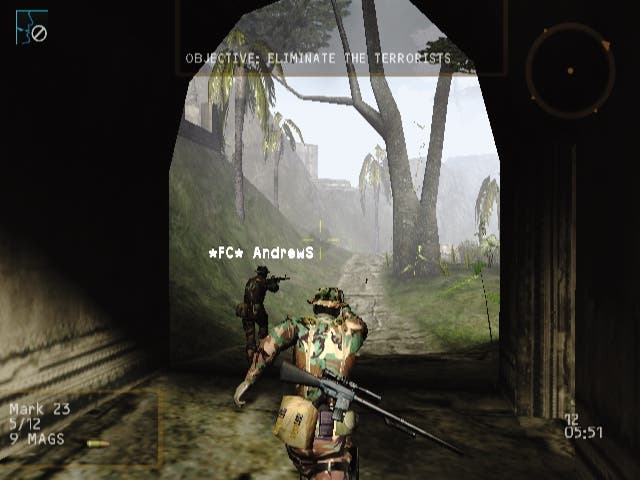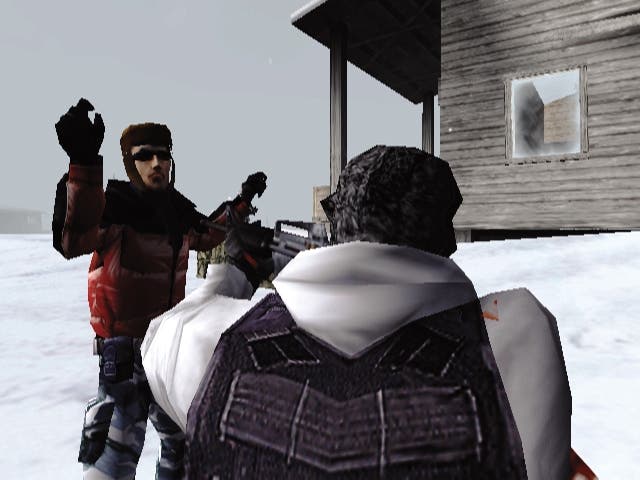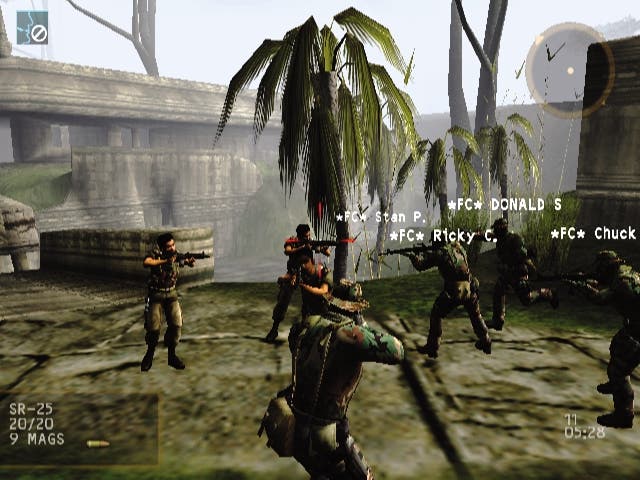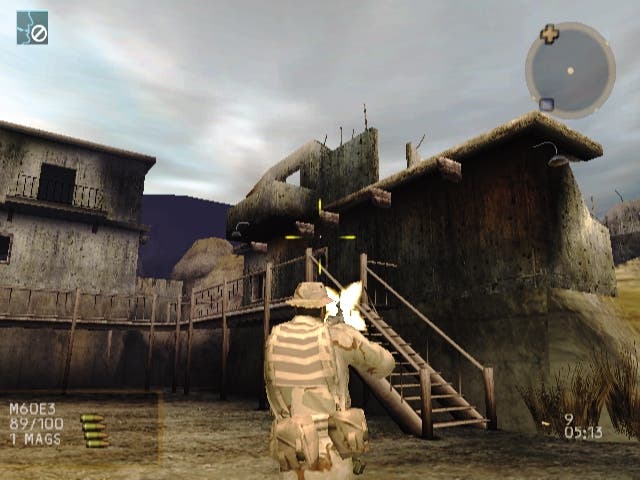SOCOM: US Navy SEALs
Online gaming comes to PS2. Quietly.
Shooting people has always been at the heart of online gaming, so it's no surprise that the third person tactical shooter SOCOM: US Navy SEALs is currently throbbing away inside our PS2s with their newly strapped-on network hardware. And rather like the best Xbox Live offerings, Zipper Interactive delivers a pretty vast single player distraction to boot - a 12-mission, team-based campaign built around a Rainbow Six style dynamic. But with a £50 price tag for the game and a bit of multiplayer-oriented headwear, SOCOM still has a heck of a lot to prove.
Cooped up

However before we could even prove it worked we were thwarted by what is - for us at least - one of the game's chief failings: simply put, there's no real cohesion between single and multiplayer. We didn't even want to settle down and play it on our own, see; we wanted to hook up a row of PS2s in the office, snaking cables over furniture and round the necks of naysaying art junkies, and clobber terrorist scum co-operatively, much as we've been doing in the sublime Raven Shield ever since we first got our hands on it.
But alas this is something you cannot do. The single player game has been designed from the ground up to accommodate one soldier with virtual team-mates, who can be directed up to a point by simple instructions dispensed through the bundled Logitech headset. "Bravo to Charlie", "hold your fire", "deploy satchel charge" etc. Using this primitive lingo you have to manoeuvre through carefully constructed mission plans utilising overhead maps, positional data and by observing sentry patterns, storming buildings and generally killing enemies. Mostly Russian, as it happens.
Once you're done with the 12 reasonably expansive (and/or frustratingly difficult) single player missions, or if you'd simply rather avoid them completely, you can go online and take on gamers from across Europe and the world in three Counter-Strike inspired variations on the traditional Team Deathmatch: Suppression, Extraction and Demolition. It's this mode that makes the most use of your headset, and in our opinion it's the only part worth turning up for.
Could do with some help

This is because, the lack of co-operative support aside, the single player game is still pretty close to terrible. It combines a lot of good ideas (mostly seen before), but it doesn't infuse the same "one more go" mentality as Raven Shield, or even Ghost Recon. It doesn't train you up, even at all, preferring instead to drop you into action on a barge somewhere, with one of the most annoying opening missions we've ever seen in this sort of game.
After taking control of your SEALs, the idea is to sneak around the barge, which is docked with a terrorist vessel, killing sentries and hiding their bodies before launching a stealthy assault on the other ship. Unfortunately it took us about fifteen goes before we could successfully clobber the four or five guards on the lower decks of the barge without being seen, and our frustration was compounded by the discovery that you needn't even bother. As long as you can race up the stairs and shoot a few people using the auto-aim, pop a hole in some ineptly-guarded radio circuitry, gather up some papers downstairs and then plant some charges in the bowels, you can open up the second mission in a couple of minutes. We never even completed the "eavesdropping for enemy intel" sub-objective until we ran headlong into trouble and holed ourselves up behind a crate to reload...
After a few more missions, which took us through some icy wastelands dotted with outhouses and old mining facilities, capturing terrorist defectors and blowing things up, and across the darkened flats of a terrorist-controlled oilrig defusing bombs, it became apparent that the in-game "Help" system - which serves as a tutorial of sorts - misses more times than it hits, offering precise instructions in some cases and useless, ambiguous crap like "identify the snipers" in others. Being repeatedly subjected to "you botched the insertion, team" messages from the irritating mission briefing woman didn't help us identify what we were supposed to do, neither did creeping, binoculars at the ready, towards the position we knew the enemy sniper to be in. He just spawned out of nowhere if we got too close without doing it 'properly'.
It's a theme that runs throughout the 12-mission campaign. You never gain a sense of intuition as to what you should do in any given situation, so all the game consists of is repeating certain missions until you're as blue as your wetsuit (there is no mid-level save of course), barking orders into a headset (which, amazingly, seems to have more difficulty understanding things the more you say), moving between markers without alerting too many people, and completing simple mission objectives. Over and over until you can do them all in one go.
Terrifying

Perhaps in order to compensate for all the repetition, Zipper has coded some embarrassingly stupid artificial terrorists. Although they do pleasingly speak in Russian and other obvious terrorist tongues - with English subtitles - they seem incapable of spotting you or a dead body more than about five feet from their eyes, or even someone being shot right in their field of view, unless it's a bright summer's day and you're firing an AK-47 at them.
Or if the game feels like it. Because in some instances they are capable of radioing one another and detonating mission-critical bombs if they don't hear back within five minutes, or spotting you even before you've spotted them when the objective calls for a bit of enemy intelligence. But these are the same terrorists who, faced with a Navy SEAL disarming their explosives, cheerily upend their loaded Kalashnikovs and attempt to rifle-butt you to death. The CIA spent $3 billion on terrorist training camps and this is the best they could muster? No wonder they're trying to catch beardy bin Laden. They probably want their money back.
We certainly hope SCEA didn't blow anything near that on the game engine, because SOCOM looks (and, er, is) about a year overdue. It's more Conflict: Desert Storm than Halo or Frontline, with blocky environments, overused textures and dull enemy models. You get some quite nice animation now and again (hand gestures from fellow SEALs, throwing downed enemies over your shoulder, and things of that nature), some night vision view modes, and a bit of sniping, but for counter-terrorism visuals it's not going to trouble Ubi Soft Montreal, Red Storm and all the rest. And, given the built-in lean function and sniper modes, we hadn't expected to find so many bullets hitting the scenery we leant around, despite our crosshairs clearing it by a good few inches.
Mercifully we did chance upon the occasional glimmer of hope. The game has a similar "flashbang and clear" model to Raven Shield for dealing with suspicious doors, and here you can direct it all via voice instead of delving into a series of mouse menus, so thumbs up for that. You can also change your rate of fire, use all manner of munitions and there are three stances - standing, crouched and prone - all of which play some important part. You can even ad lib your mission plan to a certain extent, putting off the task of destroying weapon stockpiles until the end to avoid undue surprises, or leaving some of the more boring "done it five times already" sub-objectives to rot, but on the whole we'd prefer it if SOCOM took a stand one way or another.
Is it, or is it not, a precise counter-terrorism sim? If not, then why make it so bleedin' hard to get anything done? If so, then why not implement backup plans for certain contingencies? At least give the player the impression that this isn't Barney the Dinosaur does 24.
Enemy defection

It's fair to say then that most people will be spending their time playing the game online, and those of you who spent £50 on some sort of single player whim will either be returning the game forthwith or storing it with other failed impulse purchases. Or extolling the game's under appreciated virtues vociferously a few inches below my conclusion. Whichever way, those of you living under a stone outside a DSL or cable area can safely take off now. We're about to "hook ourselves up".
Multiplayer SOCOM is a very different kettle of terrorism, and errs more on the side of "tremendously enjoyable" than "frustrating, sub-Desert Storm crap". Each of the three modes enjoys much the same dynamic at Counter-Strike, as two evenly divided teams of real life terrorist and SEAL folk spawn at different ends of a map and then charge headlong towards choke points and objectives (like picking up the bomb, liberating hostages or defusing the enemy hardware). Along the way they launch volleys of fire at one another and sometimes lock themselves in stand-offs, with one team holed up in a well-guarded but strategically useless room and the other trying to lure them out or kill them all with grenades. These are exciting for those involved but less so for those stranded in limbo. You see, once dead nobody respawns until the next round, but beyond picking out the next game's weapons and explosives, all there is to do is refresh the scores menu and chat away on your headsets about your mutual ineffectiveness in combat.
Shamelessly Counter-Struck

In a recent piece on the Xbox version of Counter-Strike, Rob correctly identified that the play dynamic is very different when nobody's any good at the control scheme, and suggested that maybe, just maybe, CS on Xbox will prove more of a level playing field, without all the rookies getting stamped out immediately by superior twitch-killers. On the evidence of SOCOM though, which does ostensibly the same thing as CS on Xbox, the gulf of talent is still bound to rear its ugly head. Here at EG, we're not going to trouble the true Halo junkie with our double analogue stick skills, but we're hardly inept either. Nevertheless, we spent our first few games of SOCOM played online being killed not after a couple of minutes, but within seconds. Some maps, you see, are a lot smaller than CS alternatives, with spawn points much closer together, so anybody willing to make a dash about 50 feet to the left is going to find plenty of easy pickings. Everybody else tends to run off towards the real playground with its buildings, ramps, sniper spots, hostages, bombs or what-have-you, but many just clobber the newbies.
We're not naïve enough to say it wouldn't happen without the built-in incentives, but the kill-oriented world rankings and MVP (Most Valued Player) awards for each game don't exactly inspire courteous teamplay. In fact they do quite the opposite. Chatting to a few of the people playing SOCOM just after launch - namely the ones who ran from spawn to spawn and got wiped out, having grenaded and machine gunned several others including me - it became apparent that all they want is recognition. "I reckon if I keep my kill level up, I'll see my name in official PlayStation magazine," someone said. "Yeah." "Good idea." "Which gun's best for ploughing through newbie scum?" Etc.
Terrorists win

That said, not everybody plays like that. It is definitely possible to locate bands of players who will sneak around levels together, whispering instructions in your ear, working to capture objectives properly and actually playing the game as it was intended. Some of them have even formed clans, and don't mind offering a bit of advice over voice comms, so if you come across a new map there are usually a couple of good-hearted individuals happy to offer some advice if they get bumped off early on.
However some of us will simply never get it, and some people are so good at it as to dominate every game they play in. The fundamentals of CS still apply here on almost every level - superficially the gameplay isn't much different, neither are the maps, and deep down it's the same idea. Overall, if you can't handle the third person, double stick controls without the comforting auto-aim toggle of the single player outing, then you're probably better off sticking to the PC. CS runs on less than stellar rigs, and if you do have decent kit, a combination of Raven Shield and the free Counter-Strike offers a more rounded experience in every respect.
Some of you will of course prefer to stick to consoles, and some would argue that SOCOM is alone right now in offering a CS-style tactical multiplayer kick, but on the whole we just can't recommend it. We don't even have time to go into some of our less important criticisms, like our dislike of the user interface - with its "if you leave the briefing screen we'll make you listen to the whole goddamn thing again" mentality. PS2 owners haven't much else to go for at the moment, but at £50 the single player game doesn't deliver, and at what is effectively £75 the multiplayer game has been done better elsewhere, with too steep a learning curve in this case for newcomers. If you're adept with the Medal of Honor/Halo style control scheme then by all means prove us wrong and shake your weary fists at us in combat, but if you're uncertain then we recommend you try it out before committing, or simply wait for SOCOM 2. Based on our trip to E3, we're bound to say nicer things about that.

